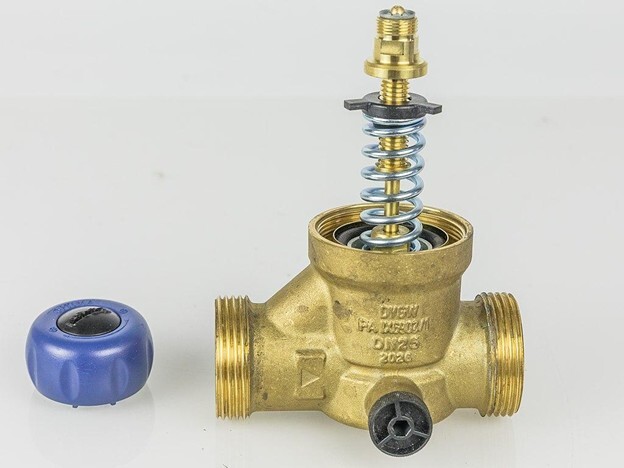
Precision Pressure Regulator
Precision Pressure Regulator
Shop Precision Pressure Regulator Shop Now
Back Pressure Regulator
Back Pressure Regulators
Shop Back Pressure Regulators Shop Now
Pressure Reducing Valve
Pressure Reducing Valve Regulators
Shop Pressure Reducing Valve Regulators Shop NowA pressure regulator is a type of valve that controls the pressure of a fluid, using upstream or downstream pressure as a reference. Pressure regulators are used for liquids and gases. Regulators are essential in various systems, from protecting household plumbing and fixtures against excessive water pressure, to controlling pressures in industrial processes, ensuring safety and equipment functionality. Pressure regulators may take the form of an integral device with a pressure setting element, flow restrictor and pressure sensor all in one body, or consist of separate pressure sensor, controller and flow control valve.
How do Pressure Regulators Work?
Pressure regulators work by adjusting the valve opening in response to changes in upstream or downstream pressure. A spring-loaded diaphragm is often used to automatically adjust the position and maintain the pressure setting of the valve.
Valves may be controlled by upstream or downstream pressure. For example, if the outlet pressure drops, the spring pushes against the diaphragm which opens the valve wider, allowing more fluid to flow through the valve. Conversely, if the outlet pressure rises, the diaphragm is pushed back against the spring, which closes the valve and reduces the flow, bringing the pressure back to the desired level.
Types of Pressure Regulators
Pressure regulators may be classified into two main types, pressure reducing regulators and back pressure regulators. Other categories include the number of stages (single or dual stage regulators), actuation method (spring loaded or pilot operated regulators), and their ability to release excess pressure (pressure relieving regulators).

Pressure Reducing Regulators
A pressure reducing regulator, also known as a pressure reducing valve, is a control valve that reduces the inlet pressure of a fluid to a desired value at its outlet. In other words, pressure reducing regulators maintain a set downstream pressure, even if the upstream pressure varies. These valves are often installed upstream of pressure-sensitive equipment.
Back Pressure Regulators
A back-pressure regulator, also known as back-pressure valve, pressure-sustaining valve or pressure-sustaining regulator, is a control valve that maintains a set pressure at its inlet side, even when downstream conditions change.
Advantages Of Using Pressure Regulators
Some benefits of using pressure regulators include:
- Regulators prevent overpressure and maintain a safe operating pressure, reducing the risk of equipment failure and leakage.
- Regulators provide a fast and automatic response to changes in system conditions.
- Regulators enhance efficiency in systems and processes that require consistent and steady pressure.
- Regulators protect sensitive equipment from damage due to excessive pressure.
Disadvantages Of Using Pressure Regulators
Disadvantages of pressure regulators include:
- Regulators operate effectively within a limited flow range, and operating outside this range may lead to poor performance.
- Regulators or their pilot fittings may be exposed to debris or mineral build-up, which can block valve passages and negatively impact flow through the valve or reduce control functionality.
- Regulators can only achieve a limited pressure reduction ratio, operating at a higher reduction ratio may lead to cavitation, unstable operation, excessive noise and severe vibration.
Pressure Regulator Applications
Pressure regulators are suited to liquid, gas and steam applications. They are used in a broad range of industries, from manufacturing, oil and gas, chemical processing and power generation. Aside from industrial applications, pressure regulators are used in domestic and commercial buildings, utilities like water and natural gas, HVAC, automotive and healthcare sectors. Some examples of their use include:
- Regulating the flow of compressed air for pneumatic equipment and processes.
- Managing and maintaining water supply pressure in complex municipal water zonal supply systems.
- Controlling the flow of gas to heaters, burners or other gas appliances.
- Reducing pressure to prevent over pressurizing downstream pipes or equipment.
- Precise pressure control for applications such as chemical processing, tank blanketing, sampling and dosing.

How to Specify a Pressure Regulator
Specifying a pressure regulator may seem daunting at first, below are a few key considerations in selecting the right valve:
Upstream pressure: The supply pressure or inlet pressure at the valve.
Downstream pressure: The outlet pressure at the end of the valve.
Pressure differential: The difference between upstream and downstream pressure, or in other words, the change in pressure across the valve.
Flow range: The range of flows the valve needs to cater for, this is important so that the valve isn't undersized or oversized.
Fluid type: Is it a liquid, gas, or steam? Are fluid parameters like density, viscosity, particle size and temperature known?
Once you have specified and sized a regulator based on the performance requirements, other factors such as material selection, end connection type, bonnet style and actuation requirements may be considered.
In summary, the most important aspects when selecting a regulator are; what is the flow medium, what the desired flow rate (or flow range), and what is the required inlet and outlet pressure.
Are Pressure Regulators the Right Pressure Control Valve for you?
A pressure regulator is the right control valve if you want to maintain a consistent, preset upstream or downstream pressure, regardless of pressure or flow fluctuations, and without needing an external power supply or manual intervention.
Pressure regulators may be used to protect equipment from over-pressure, ensuring consistent supply pressure to a process, or to ensure that a system's pressure meets requirements. However, if your system requires precise, automated control of both pressure and flow over a broad flow range, or if your flow range exceeds a regulator's capacity, then a more complex control valve may be the better option.

 888-825-8800
888-825-8800







